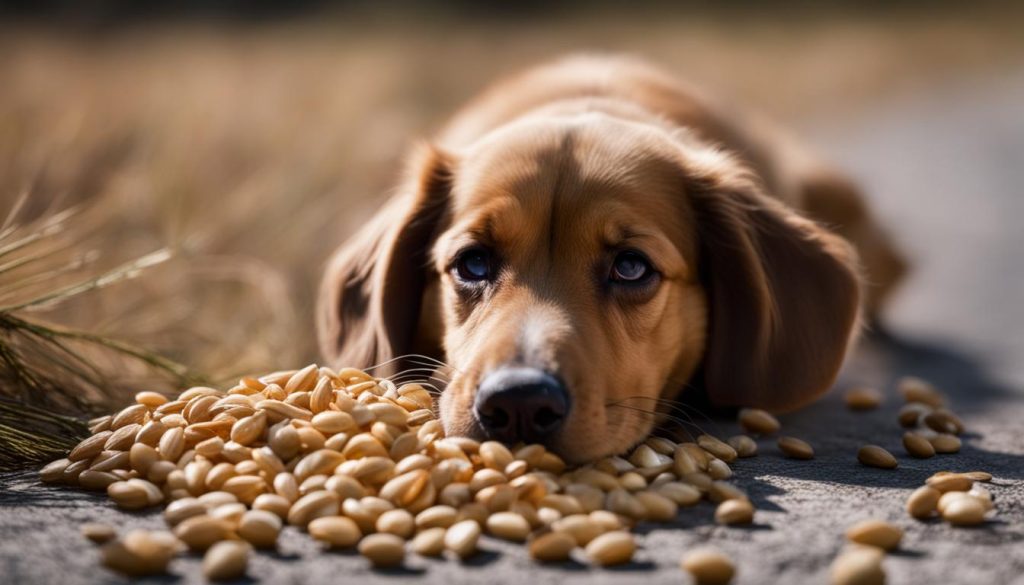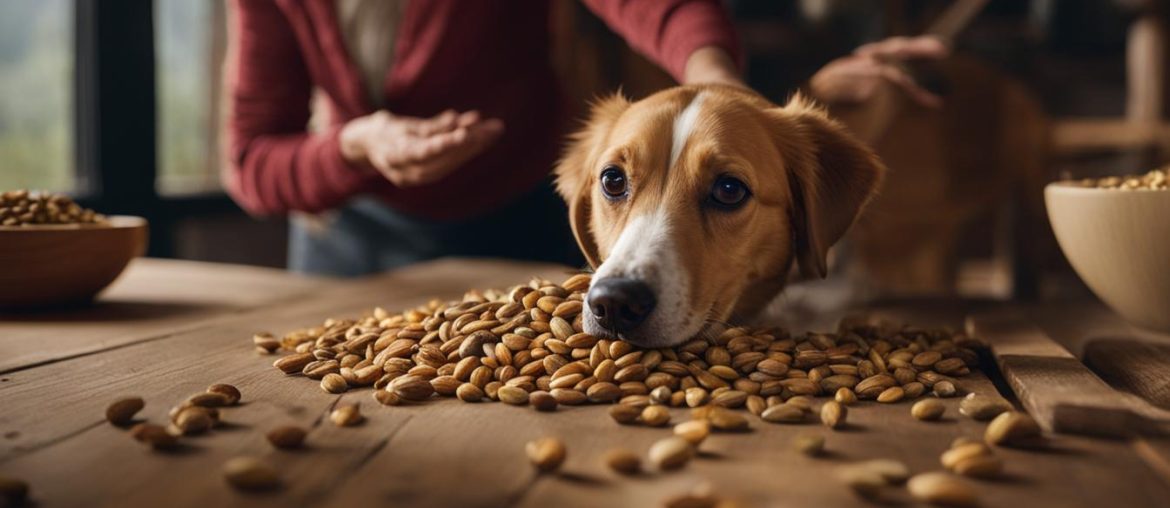Welcome to my informative article about dogs and pine nuts. As a professional copywriting journalist, I am here to provide you with valuable insights into the topic of pine nuts and their suitability for dogs. In this article, we will explore the nutritional benefits of pine nuts, potential risks of feeding them to dogs, and best practices for incorporating nuts into your dog’s diet. Let’s dive in!
Key Takeaways:
- Pine nuts are not toxic to dogs but should be given as an occasional treat due to their high fat content.
- Consult your vet before introducing any human food, including nuts, to your dog’s diet.
- Pine nuts contain antioxidants, zinc, iron, and magnesium, which can be beneficial for a dog’s heart health.
- The main risk of feeding pine nuts to dogs is their high fat content, which can lead to weight gain and pancreatitis.
- Some dogs may be allergic to pine nuts, so it’s important to monitor for any signs of allergies or adverse reactions.
Nutritional Benefits of Pine Nuts for Dogs

Pine nuts, despite their high fat content, can offer some nutritional benefits for dogs when consumed in moderation as part of a balanced diet. These small seeds are rich in antioxidants, zinc, iron, and magnesium, which contribute to a dog’s overall health.
Antioxidants play a key role in neutralizing harmful free radicals in the body, reducing the risk of oxidative stress and promoting a healthy immune system. Zinc is essential for cellular metabolism, wound healing, and maintaining a healthy coat and skin. Iron supports the production of red blood cells, ensuring proper oxygen transport throughout the body. Magnesium is involved in various enzymatic reactions and helps regulate nerve and muscle function.
However, pine nuts should only be given as a small part of a dog’s diet. Their high fat content makes them calorie-dense, and excessive consumption can lead to weight gain, pancreatitis, and urinary tract problems. Therefore, it’s crucial to consult with a veterinarian before introducing pine nuts or any other human food to your dog’s diet.
Table: Nutritional Content of Pine Nuts
| Nutrient | Amount per 100g |
|---|---|
| Calories | 673 |
| Protein | 13g |
| Fat | 68g |
| Carbohydrates | 13g |
| Fiber | 4g |
| Calcium | 16mg |
| Magnesium | 251mg |
| Iron | 5mg |
| Zinc | 6mg |
Source: USDA National Nutrient Database
While pine nuts can provide certain nutritional benefits for dogs, it’s essential to strike a balance and prioritize their overall health. A veterinarian can provide guidance on incorporating pine nuts into your dog’s diet, taking into consideration their specific dietary needs, any preexisting health conditions, and potential risks associated with excessive fat consumption.
Risks of Feeding Pine Nuts to Dogs

Feeding pine nuts to dogs can pose certain risks due to their high fat content. While not toxic, excessive consumption of pine nuts can lead to weight gain and increase the likelihood of pancreatitis and urinary tract problems. Additionally, some dogs may be allergic to pine nuts, which can cause gastrointestinal issues such as upset stomach, vomiting, lethargy, and diarrhea. It is important to closely monitor your dog for any signs of allergies or adverse reactions when introducing pine nuts into their diet.
To prevent these risks, it is recommended to limit the amount of pine nuts given to dogs and treat them as an occasional indulgence rather than a regular part of their diet. Consulting with a veterinarian is always a good idea before introducing any new food to your dog, including pine nuts. If your dog tolerates pine nuts well and shows no signs of allergies or digestive issues, you can continue to offer them as a special treat, but it’s important to ensure they don’t consume excessive amounts.
Pine Nut Allergies in Dogs
Some dogs may develop allergies to pine nuts, which can manifest as various symptoms including upset stomach, vomiting, lethargy, and diarrhea. Allergic reactions can vary in severity, and it is important to closely monitor your dog for any signs of discomfort or adverse effects. If you suspect your dog is allergic to pine nuts, it is best to avoid giving them this particular treat and opt for a safer alternative.
Introducing Pine Nuts to Your Dog

When it comes to introducing pine nuts to your dog, it’s important to proceed with caution and follow a few guidelines. Here are some steps to help you introduce pine nuts as a treat for your furry friend:
- Start small: Begin by offering your dog just a few pine nuts as a treat. This will allow you to gauge their reaction and ensure they tolerate the nuts well.
- Mix with food: To make the introduction easier, you can mix a small amount of pine nuts into your dog’s regular food. This will help them become accustomed to the taste and texture of the nuts.
- Monitor for reactions: After giving your dog pine nuts, closely observe them for any signs of digestive upset or allergies. If they experience any adverse reactions, such as vomiting or diarrhea, it’s best to discontinue feeding them pine nuts.
- Occasional treat: If your dog tolerates pine nuts well, you can continue to offer them as an occasional treat or special snack. Remember to keep the portion size small to avoid excessive fat intake.
By following these steps, you can gradually introduce pine nuts to your dog’s diet and assess their response. It’s always important to prioritize your dog’s health and consult with a veterinarian if you have any concerns or questions.
Table: Introduction of Pine Nuts
| Steps | Details |
|---|---|
| Start small | Offer a few pine nuts as a treat to gauge your dog’s tolerance and reaction. |
| Mix with food | Introduce pine nuts by mixing them into your dog’s regular food to familiarize them with the taste and texture. |
| Monitor for reactions | Observe your dog for any signs of digestive upset or allergies after feeding them pine nuts. Discontinue if any adverse reactions occur. |
| Occasional treat | If your dog tolerates pine nuts well, continue to offer them as an occasional treat or special snack, in small portion sizes. |
Remember, every dog is unique, and their reaction to pine nuts may vary. It’s essential to introduce new foods gradually and monitor your dog’s response to ensure their well-being. As with any dietary changes, it’s always a good idea to consult with your veterinarian for personalized advice based on your dog’s specific needs and health conditions.
Safe Nuts for Dogs to Eat

When it comes to feeding nuts to dogs, not all types are safe for consumption. However, there are a few nuts that can be given to dogs in moderation as a treat. Here are some safe nuts for dogs:
- Peanuts: Unsalted and unseasoned peanuts are generally safe for dogs. However, it’s important to ensure that your dog doesn’t have any allergies or digestive issues before giving them peanuts.
- Cashews: Roasted cashews can be given to dogs in small quantities. It’s crucial to avoid giving them salted or flavored cashews, as these can be harmful.
- Brazil Nuts: Brazil nuts can be offered to dogs in small amounts. They provide essential nutrients and can be a healthy addition to their diet.
Please be aware that while these nuts are considered safe, they should still be given in moderation. Excessive consumption of nuts can lead to weight gain and other health issues in dogs.
| Nut | Safety for Dogs |
|---|---|
| Peanuts | Safe in moderation |
| Cashews | Safe in small quantities and unsalted |
| Brazil Nuts | Safe in small amounts |
Remember to always consult with your veterinarian before introducing any new food into your dog’s diet, including nuts. They can provide personalized advice based on your dog’s specific needs and ensure their overall health and well-being.
Unsafe Nuts for Dogs
When it comes to feeding nuts to dogs, not all varieties are safe for them to consume. Certain nuts can pose risks to a dog’s health and should be avoided entirely. Among the unsafe nuts for dogs are almonds, walnuts, pistachios, hazelnuts, and macadamia nuts.
Almonds, in particular, can cause gastrointestinal problems and can also be a choking hazard for dogs. On the other hand, walnuts, especially black walnuts, may contain toxic substances that can lead to seizures in dogs. Pistachios, despite being a popular human snack, can contain harmful toxins that are not suitable for canine consumption. Hazelnuts carry the risk of mycotoxin ingestion, which can be harmful to dogs. Finally, macadamia nuts are extremely toxic to dogs and should never be given to them under any circumstances.
It is important for dog owners to be aware of these unsafe nuts and to avoid feeding them to their furry companions. By doing so, they can help protect their dog’s health and prevent any potential negative reactions or illnesses.
| Nut | Reasons |
|---|---|
| Almonds | Gastrointestinal problems and choking hazard |
| Walnuts | Possible presence of toxic substances leading to seizures |
| Pistachios | Potential harmful toxins |
| Hazelnuts | Risk of mycotoxin ingestion |
| Macadamia nuts | Extremely toxic and should never be given to dogs |
Instead of offering these unsafe nuts, dog owners can opt for other safe and healthier alternatives as treats for their furry friends. This way, they can ensure that their dogs receive appropriate and nutritious snacks without compromising their well-being.
Other Considerations for Feeding Nuts to Dogs

While nuts can offer certain nutritional benefits for dogs, it’s important to approach them with caution. Nuts should not be a significant part of a dog’s diet and should only be given as occasional treats or snacks. Dogs have different digestive systems than humans and may not process fats and calories efficiently, which can lead to weight gain and other health issues.
When feeding nuts to your dog, it’s crucial to limit portion sizes to avoid overconsumption of fat and calories. It’s also essential to avoid nuts with added seasonings, sugars, or salts, as these can be harmful to your dog’s health. Nutshells should be avoided, as they can pose choking and blockage hazards.
Instead of relying solely on nuts as treats, there are many safer and healthier alternatives available. Consider offering your dog carrot sticks, apple slices, blueberries, or vet-approved dog treats that are specifically formulated for their nutritional needs. These alternatives provide essential nutrients, are lower in fat and calories, and reduce the risk of potential allergies or digestive issues.
The Role of a Balanced Diet
A balanced and appropriate diet is key to maintaining your dog’s overall well-being. While a small portion of nuts may offer certain benefits, it’s important to consult with a veterinarian before making any changes to your dog’s diet. A vet can provide personalized advice based on your dog’s specific dietary needs, allergies, and health conditions.
Remember, every dog is different, and what works for one may not work for another. Consulting with a vet will ensure that you’re providing your furry friend with the best possible care and nutrition. By following expert guidance, you can ensure a well-rounded diet for your dog that includes safe and healthy treats.
Best Practices for Feeding Dogs Nuts

Feeding nuts to dogs can be a treat for them, but it’s important to follow some best practices to ensure their safety and well-being. Here are a few guidelines on how to serve nuts to dogs:
- Limit portion sizes: Nuts should only be given in small quantities as occasional treats. This helps prevent overconsumption of fats and calories, which can lead to weight gain and related health issues.
- Avoid added seasonings and salts: Opt for plain nuts without any added flavors, seasonings, sugars, or salts. These additives can be harmful to your dog’s health and may cause digestive problems.
- Watch out for nutshells: Nutshells can pose a choking hazard and may also cause blockages in your dog’s digestive system. Make sure to remove the shells before offering nuts to your furry friend.
- Roasted or boiled nuts: Raw nuts carry a higher risk of containing molds or fungi that can be toxic to dogs. It’s safer to serve roasted or boiled nuts to minimize this risk.
By following these best practices, you can ensure that your dog enjoys nuts as a special treat without compromising their health. Remember, moderation is key, and it’s always a good idea to consult with your veterinarian before introducing any new foods to your dog’s diet.
| Nut | Serving Size | Precautions |
|---|---|---|
| Peanuts | Small quantities | Ensure no allergies or digestive issues |
| Cashews | Roasted and in small quantities | Avoid excessive amounts due to high fat content |
| Brazil nuts | Small amounts | Monitor for any adverse reactions |
While these nuts are generally considered safe for dogs, it’s important to remember that they should still be given in moderation. Always prioritize your dog’s overall diet and consult with a veterinarian for personalized advice on their nutritional needs.
Canine Obesity and Health Risks
Canine obesity is a growing concern that poses various health risks for dogs. Obesity occurs when a dog’s weight exceeds their ideal body condition, often due to excessive calorie intake and lack of physical activity. Just like humans, overweight dogs are at a higher risk of developing serious health problems.
Carrying excess weight can lead to conditions such as diabetes, heart disease, joint problems, and a reduced life expectancy. Obesity in dogs can also affect their overall quality of life, leading to decreased mobility, decreased energy levels, and a higher susceptibility to injuries. It’s crucial for dog owners to recognize the risks associated with canine obesity and take proactive steps to maintain their pet’s healthy weight.
One of the main causes of obesity in dogs is overfeeding or feeding them high-fat foods in excessive amounts. This includes treats such as nuts, which can be high in calories and fat content. While nuts may offer some nutritional benefits, they should only be given to dogs in moderation as occasional treats. It’s important to consider the overall calorie intake of your dog’s diet and consult with a veterinarian to determine the appropriate portion sizes and feeding guidelines.
In addition to managing calorie intake, regular exercise is essential in maintaining a healthy weight for dogs. Daily walks, playtime, and engaging in activities that promote physical activity can help dogs burn calories and maintain a healthy body condition. Regular veterinary check-ups are also important as they can assess your dog’s weight, provide personalized advice, and address any underlying health conditions that may contribute to weight gain.
The Risks of Overweight Dogs:
- Increased risk of diabetes
- Heart disease and high blood pressure
- Joint problems and decreased mobility
- Reduced life expectancy
- Respiratory issues
| Body Condition Score | Description | Action Needed |
|---|---|---|
| Underweight | Visible ribs, excessive weight loss | Consult with a veterinarian for dietary recommendations |
| Ideal | Well-proportioned, easily felt ribs | Maintain current feeding and exercise routine |
| Overweight | Difficulty feeling ribs, round appearance | Adjust diet and increase exercise with guidance from a veterinarian |
| Obese | Bulging abdomen, difficulty walking | Implement a weight loss plan under the supervision of a veterinarian |
Consulting with a Veterinarian
If you’re considering making changes to your dog’s diet or introducing new foods like nuts, it’s essential to consult with a veterinarian. A veterinarian is the best source of advice when it comes to your dog’s nutrition and overall health. They will have a comprehensive understanding of your dog’s individual dietary needs, allergies, and any specific health conditions that may impact their diet.
A vet can provide personalized guidance on the appropriate portion sizes, frequency of treats, and the nutritional balance your dog needs. They can help you determine if your dog can safely consume nuts and advise on the best way to incorporate them into their diet. Consulting with a veterinarian ensures that you are making informed decisions that will nourish your dog’s body and promote their well-being.
Additionally, a veterinarian can help monitor your dog for any adverse reactions to nuts or other foods. They can provide recommendations on alternative treats that are safe and healthy for your furry friend. By consulting with a vet, you can have peace of mind knowing that you are providing the best possible care and nutrition for your beloved pet.
To summarize, when it comes to your dog’s diet, it’s always wise to seek guidance from a veterinarian. They will have the expertise and knowledge to provide personalized advice based on your dog’s unique needs. By consulting with a veterinarian, you can ensure that you are making informed decisions about your dog’s nutrition and overall well-being.
Alternative Treats for Dogs
When it comes to treating our furry friends, there are plenty of safe and healthy options to consider. Instead of offering nuts, which can be high in fat and pose potential risks, I recommend exploring alternative treats that provide essential nutrients and are lower in calories.
One option is to give your dog carrot sticks. Not only are carrots low in calories, but they’re also packed with vitamins and fiber, making them a nutritious and crunchy snack for your pup. Another great choice is apple slices, which are filled with antioxidants and can help promote good dental health.
If you’re looking for a sweet and tangy treat, blueberries are an excellent choice. They are rich in antioxidants and can provide a burst of flavor without the added sugars or fats. Additionally, you can opt for commercial dog treats specifically formulated to meet your pup’s nutritional needs. These treats are often designed to be low in fat and high in beneficial ingredients.
By choosing alternative treats for your dog, you can ensure they receive a variety of flavors and nutrients while reducing the risk of potential allergies or digestive issues. Remember to always offer treats in moderation and consult with your veterinarian for personalized advice on what treats are best for your furry friend.
FAQ
Can dogs eat pine nuts?
Pine nuts are not toxic for dogs, but their high fat content means they’re not ideal for regular consumption. It’s best to consult your vet before introducing any human food to your dog, including nuts.
Are pine nuts beneficial for dogs?
Pine nuts contain antioxidants, zinc, iron, and magnesium, which can be beneficial for a dog’s heart health. However, due to the high fat content, pine nuts should only be included as a small part of a balanced diet for dogs.
What are the risks of feeding pine nuts to dogs?
The main risk is the high fat content, which can lead to weight gain, pancreatitis, and urinary tract problems. Additionally, some dogs may be allergic to pine nuts, leading to symptoms such as upset stomach, vomiting, lethargy, and diarrhea.
How should I introduce pine nuts to my dog?
Start with small quantities and observe your dog’s reaction. Offer a few pine nuts as a treat or mix them into their regular food. Monitor for any signs of digestive upset or allergies. If tolerated well, pine nuts can be given as an occasional treat or special snack.
What other nuts are safe for dogs to eat?
Safe nuts for dogs include peanuts (unsalted and unseasoned), cashews (roasted and in small quantities), and Brazil nuts (in small amounts). Peanuts, although technically legumes, are generally safe for dogs as long as they don’t have any allergies or digestive issues.
Which nuts should dogs avoid?
Dogs should avoid almonds, walnuts, pistachios, hazelnuts, and macadamia nuts. Almonds can cause gastrointestinal problems, walnuts may contain toxic substances, pistachios can contain harmful toxins, hazelnuts carry the risk of mycotoxin ingestion, and macadamia nuts are extremely toxic to dogs.
How should I feed nuts to my dog?
Limit portion sizes to avoid overconsumption of fat and calories. Avoid nuts with added seasonings, sugars, or salts. Watch out for nutshells, as they can pose choking and blockage hazards. Opt for roasted or boiled nuts, as raw nuts carry a higher risk of containing toxic molds or fungi.
What are the risks of canine obesity?
Canine obesity can lead to various health risks, including diabetes, heart disease, joint problems, and reduced life expectancy. Feeding high-fat foods, such as nuts, in excessive amounts can contribute to weight gain and increase the likelihood of obesity.
Should I consult a veterinarian before feeding nuts to my dog?
Yes, it’s crucial to consult with a veterinarian before making any changes to your dog’s diet or introducing new foods. They can provide personalized advice based on your dog’s specific dietary needs, allergies, and health conditions.
What are some alternative treats for dogs?
Safe and healthier alternatives to nuts include carrot sticks, apple slices, blueberries, and commercial dog treats specifically formulated for their nutritional needs. These options provide essential nutrients, are lower in fat and calories, and reduce the risk of potential allergies or digestive issues.






